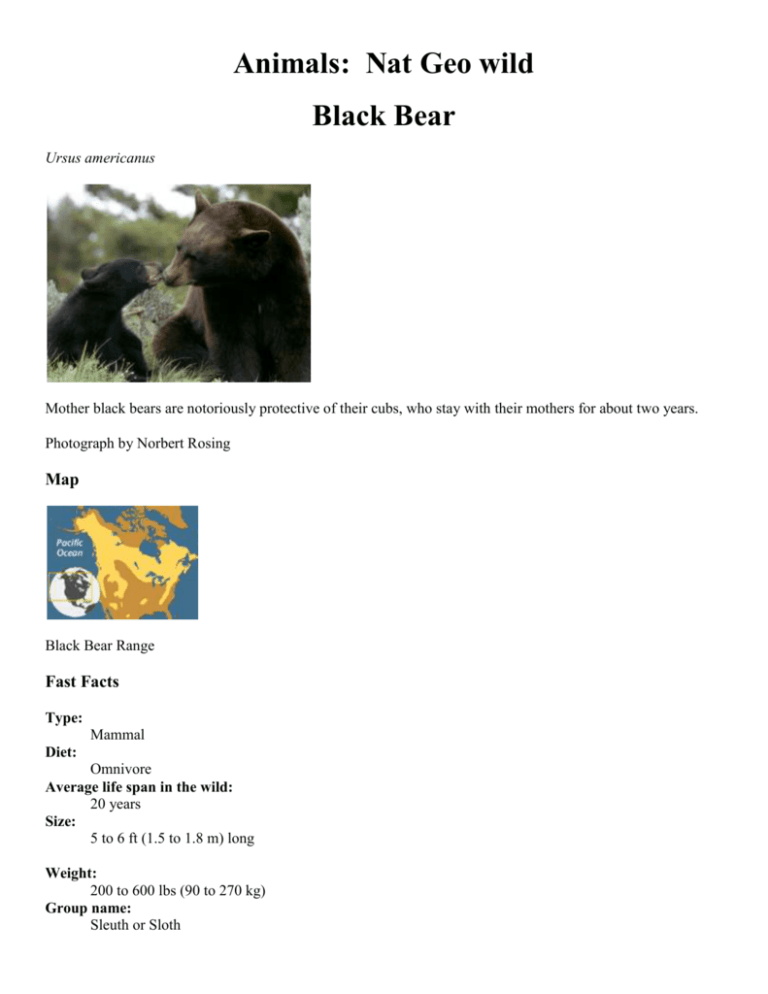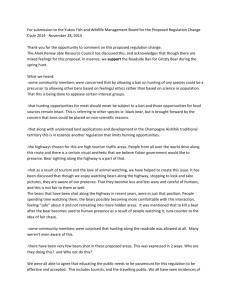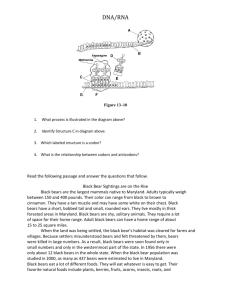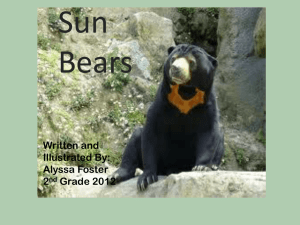Black Bear - Warren County Schools
advertisement

Animals: Nat Geo wild Black Bear Ursus americanus Mother black bears are notoriously protective of their cubs, who stay with their mothers for about two years. Photograph by Norbert Rosing Map Black Bear Range Fast Facts Type: Mammal Diet: Omnivore Average life span in the wild: 20 years Size: 5 to 6 ft (1.5 to 1.8 m) long Weight: 200 to 600 lbs (90 to 270 kg) Group name: Sleuth or Sloth Did you know? Black bears are not true hibernators. During their winter dormant period, though, they do not eat, drink, urinate, or defecate, but may wake up if disturbed. Size relative to a 6-ft (2-m) man: Black bears are North America's most familiar and common bears. They typically live in forests and are excellent tree climbers, but are also found in mountains and swamps. Despite their name, black bears can be blue-gray or blue-black, brown, cinnamon, or even (very rarely) white. Black bears are very opportunistic eaters. Most of their diet consists of grasses, roots, berries, and insects. They will also eat fish and mammals—including carrion—and easily develop a taste for human foods and garbage. Bears who become habituated to human food at campsites, cabins, or rural homes can become dangerous and are often killed—thus the frequent reminder: Please don't feed the bears! Solitary animals, black bears roam large territories, though they do not protect them from other bears. Males might wander a 15- to 80-square-mile (39- to 207-square-kilometer) home range. When winter arrives, black bears spend the season dormant in their dens, feeding on body fat they have built up by eating ravenously all summer and fall. They make their dens in caves, burrows, brush piles, or other sheltered spots—sometimes even in tree holes high above the ground. Black bears den for various lengths of time governed by the diverse climates in which they live, from Canada to northern Mexico. Female black bears give birth to two or three blind, helpless cubs in mid-winter and nurse them in the den until spring, when all emerge in search of food. The cubs will stay with their very protective mother for about two years. National Geographic http://animals.nationalgeographic.com/animals/mammals/black-bear/ The American Bear Association Black Bear Facts Did you know that although they are called black bears, colors can range from black to cinnamon brown, silverblue and, occasionally, even white? The white bears are called "Spirit" or "Kermode" bears. Ten Fast Facts About Black Bears 1. eat mostly berries, nuts, grasses, carrion, and insect larvae 2. have color vision and a keen sense of smell 3. are good tree climbers and swimmers 4. very intelligent and curious 5. can run up to 35 miles per hour 6. weigh an average of 125 to 600 pounds 7. go without food for up to 7 months during hibernation in northern ranges 8. usually give birth to 2 to 3 cubs during the mother's sleep every other year 9. can live over 25 years in the wild (average age in the wild is 18) 10. are typically shy and easily frightened Habitat Preservation Black bears have lost over 60% of their historical range. As human encroachment increases, preserving large areas of undeveloped land where bears and other animals can thrive is vital. Crucial components include adequate sources of food and water, denning sites such as rock crevices, hollow trees, and dense vegetation, contiguous travel corridors with sufficient cover for protection from poachers, harassment, and associated dangers from human development. Avoiding "nuisance" encounters in Bear Country Black bears are highly intelligent and adaptable. This species has a great capacity to live in close proximity to people. Unfortunately, many bears are shot needlessly because of unfounded fear and human carelessness. Led by a keen sense of smell, bears will naturally gravitate to potential food sources found in unsecured garbage, bird feeders, orchards, farm crops, beehives, outside pet food, and organic compost piles. FOOD AND FEAR DRIVE BLACK BEAR BEHAVIOR. Therefore: Properly store or secure all odorous food/non-food items. Use plastic bags to seal in odors and store garbage inside buildings. Use electric fences around hives, orchards, and compost piles. Attach spill pans to bird feeders and hang out of reach (10 feet up). Clear away dense brush and protective cover from yard. Don't surprise a bear; black bears tend to be nervous and easily frightened. They can cause injury if suddenly startled, cornered, or provoked. Warn a bear you are coming by occasionally clapping or using bells. Use caution when hiking in windy weather, downwind, along streams, through dense vegetation or natural food areas, and when approaching blind curves where a bear may not hear, see, or smell you. Should you encounter a black bear Stay calm - DO NOT RUN (running may elicit a chase response by the bear). Pick up children so they don't run or scream; restrain dog; avoid eye contact and talk in soothing voice. If the bear stands up, he is NOT going to attack but is curious and wants a better sniff or view. Back away slowly; if bear chomps jaw, lunges, or slaps ground or brush with paw, he feels threatened. Slowly retreat from area or make wide detour around bear; don't crowd or block bear's escape route. Note: Bear attacks on humans are extremely rare. A person is 180 times more likely to be killed by a bee and 160,000 times more likely to die in a car accident. Most injuries from black bears occur when people try to feed, pet, or crowd them. Bears will nip or cuff bad-mannered humans, as they will bad-mannered bears. They are very strong and powerful animals; bears should always be treated with caution and respect. Information prepared by Andrea Hess, Volunteer for THE AMERICAN BEAR ASSOCIATION American Bear Association http://www.americanbear.org/blackbearfacts.htm Bear Facts for Kids Facts about Black Bears SIZE Black bears are the largest land mammal in New Jersey. Adult female bears, called sows, weigh about 175 pounds. Adult male bears, called boars, weigh around 400 pounds. Black bears are about 3 feet high when standing on all four feet and 5 to 7 feet tall when standing upright. HABITAT Bears live in various types of habitat, such as hardwood forests, dense swamps and forested wetlands. SENSES Black bears can smell and hear very well. They can also climb trees and are strong swimmers. Black bears can run 35 miles per hour and can live for more than 25 years. COLOR Not all black bears have black fur. Some bears may be brown or cinnamon colored and some have a white patch of hair on their chest called a chest blaze. DIET Black bears are omnivores. They eat plants like skunk cabbage, grasses, berries, acorns and nuts. They also eat bees, ants, termites, eggs, small animals like deer fawns and dead animals. They are an opportunistic feeder, which means that they will eat any food they find available, including people’s garbage. WINTER DENS Black bears spend the winter in dens to avoid the cold weather and the lack of available food in forests. They make their dens in rock cavities, hollow trees, in nests on the ground and beneath branch piles. Inside of their dens, they go into a long winter’s sleep, called torpor. They are not true hibernators, so they may wake up and leave their dens to search for food on mild winter days. CUBS Adult females give birth in dens to baby bears called cubs. Cubs are born in January and they weigh about 8 ounces at birth. They are born blind, covered with fine hair and they nurse on their mother’s milk. Female bears may give birth to 1 to 6 cubs at a time, but 3 is the average litter size in New Jersey. Cubs grow very quickly and they weigh about 80 pounds by the time they are one year old. Young bears between the ages of one and two years old are called yearlings. Young bears stay with their mother for about one and a half years. Then, they leave the family unit in search of their own area to live, called a home range. New Jersey State Government Website http://www.nj.gov/dep/fgw/pdf/bear/bearfacts_kids.pdf Idaho Public Television: Dialogue for Kids Bear Diet Home Range Reproduction Hibernation Bear Research People & Bears Classroom Activities All About Bears There are 8 different kinds of bears - American black bears, polar bears, giant panda bears, Asiatic black bears, sloth bears, spectacled bears, sun bears and brown bears which are also known as grizzly bears. Where Do Bears Live? Black bears or their relatives live on all continents except Africa, Australia, & Antarctica. Approximately 630,000 - 725,000 American black bears live in 42 states. They also inhabit 11 Canadian provinces. Grizzly bears (also known as brown bears) and polar bears also inhabit North America. The most common bear in Idaho is the Ursus americanus otherwise known as the American black bear. Baby bears are called cubs, female bears are called sows and male bears are called boars. Links Facts Glossary References Bear Senses In the forest, bears rely on their acute hearing and super sense of smell. Their noses perceive smells much fainter than humans can detect. With this super sense of smell, they can detect other animals that are near by, and they can find fruit, insect larvae, and the other foods. Bears can probably see as well as humans can. They can recognize shapes but not details at a distance, and they observe moving objects better than stationary objects. When you've got to find lots of food on the ground, sharp eyes that see color can come in handy. And that's exactly what the black bear has. Although their night vision is also excellent, bears forage for fruit during the day when they can perceive colors. How big is a bear? Brown bears and polar bears are the biggest bears. They can be over 6 feet long and can weigh from 100 to 600 pounds. Sun bears which live in southeast Asia are the smallest bears. They weigh about 100 pounds or 45 kg. Massiveness isn't the only myth about bears. We see them everywhere depicted as cuddly stuffed toys, as humanlike characters in fairy tales and cartoons, and as ferocious beasts. But few people ever see the real thing as a beautiful, shy animal that is far from both its cute toy image and its man-killing myth. How Big Is A Bear? Nearly everyone has a bear story to tell. In almost all cases, the bear Newborns was huge! Eight ounces (0.22 kg) Bear weight estimates of more than 400 pounds are common. Even bear researchers have a tough time judging the size of a bear. One-year-old females 30-50 pounds (13.5-22.5 kg) According to John Beecham - bear researchers often have contests to see who could come closest to guessing a bear's weight, and they often over guessed the weight by 50 pounds. Mature females 120-140 pounds (54-63 kg) 51-54 inches (127.5-135 cm) One-year-old males 50-70 pounds (22.5-31.5 kg) Mature males 240-280 pounds (108-126 kg) 56-61 inches (140-152.5 cm) Bear Feet Bears walk on their feet as humans do, with their soles flat on the ground. (If you look at other mammals, such as a cat or dog, you'll see that they walk on their toes.) Look for tracks like these: Also look for scat deposited in piles of thick cords that resemble horse manure except that it is full of insect parts and, in late summer, berry pieces. Idaho Public Television http://idahoptv.org/dialogue4kids/season7/bears/facts.cfm







